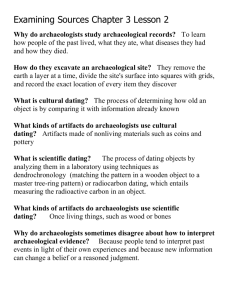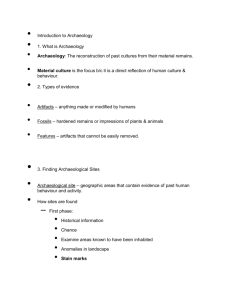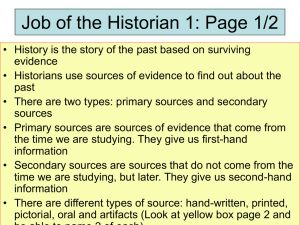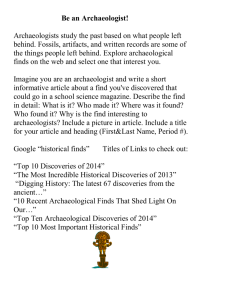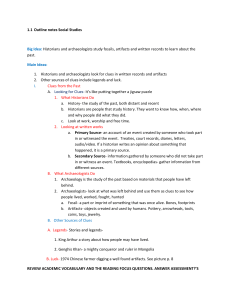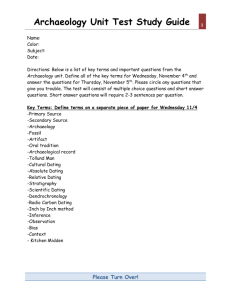userfiles/202/my files/grade 6 ch 3 notes?id=441455
advertisement
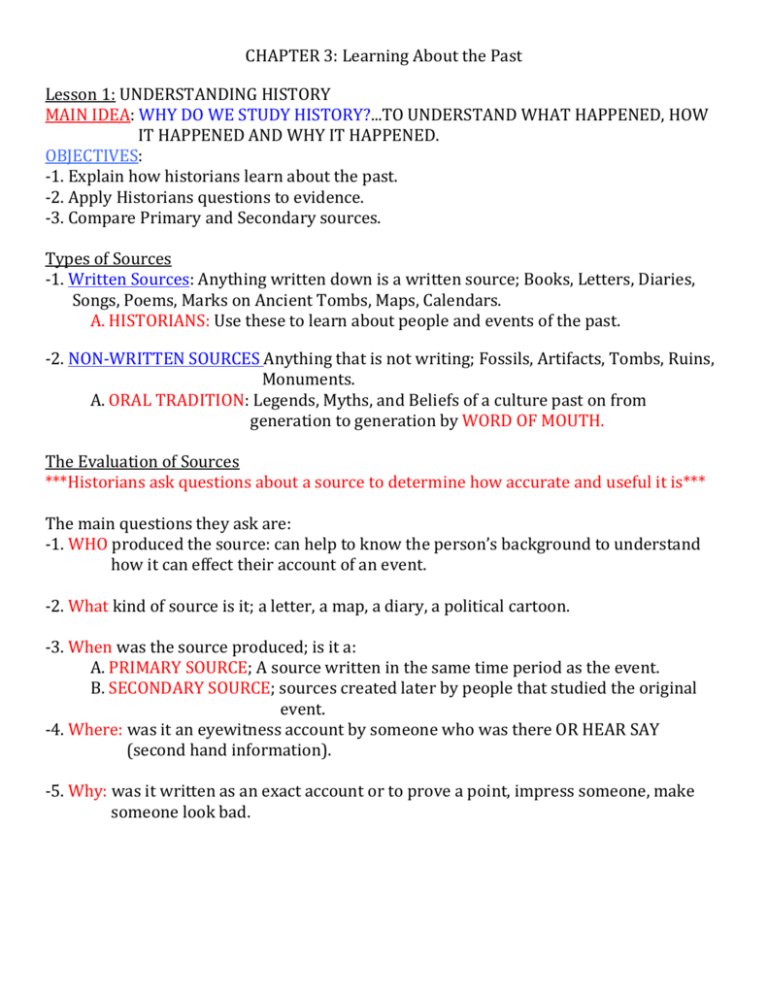
CHAPTER 3: Learning About the Past Lesson 1: UNDERSTANDING HISTORY MAIN IDEA: WHY DO WE STUDY HISTORY?...TO UNDERSTAND WHAT HAPPENED, HOW IT HAPPENED AND WHY IT HAPPENED. OBJECTIVES: -1. Explain how historians learn about the past. -2. Apply Historians questions to evidence. -3. Compare Primary and Secondary sources. Types of Sources -1. Written Sources: Anything written down is a written source; Books, Letters, Diaries, Songs, Poems, Marks on Ancient Tombs, Maps, Calendars. A. HISTORIANS: Use these to learn about people and events of the past. -2. NON-WRITTEN SOURCES Anything that is not writing; Fossils, Artifacts, Tombs, Ruins, Monuments. A. ORAL TRADITION: Legends, Myths, and Beliefs of a culture past on from generation to generation by WORD OF MOUTH. The Evaluation of Sources ***Historians ask questions about a source to determine how accurate and useful it is*** The main questions they ask are: -1. WHO produced the source: can help to know the person’s background to understand how it can effect their account of an event. -2. What kind of source is it; a letter, a map, a diary, a political cartoon. -3. When was the source produced; is it a: A. PRIMARY SOURCE; A source written in the same time period as the event. B. SECONDARY SOURCE; sources created later by people that studied the original event. -4. Where: was it an eyewitness account by someone who was there OR HEAR SAY (second hand information). -5. Why: was it written as an exact account or to prove a point, impress someone, make someone look bad. Lesson 2: EXAMINING SOURCES MAIN IDEA: Archaeologists use various methods to learn about the artifacts, bones, ruins and fossils they uncover from the past. OBJECTIVES: -1. Identify contributions of other fields of study to history. -2. Describe how the archaeological record is formed. -3. Choose appropriate dating methods for evidence. -4. Explain how archaeologists investigate ancient cultures. ARCHAEOLOGICAL RECORD: The artifacts, ruins, bones and fossils archaeologists find and study. -1. Archaeologists study the Archaeological record to learn how people lived, what they ate, what diseases they had and how people died in the past. EXCAVATION: When ruins or artifacts have been buried or covered by the forces of nature for many years Archaeologists must EXCAVATE a site to find any remains. HOW: Archaeologist find a site and divide it into squares with GRIDS. Then they carefully dig in each square and record the exact location of everything they find. Dating the Information: Archaeologist must DATE ARTIFACTS or determine their age, they use two (2) methods. Cultural Dating: Archaeologist sometimes need to gather information to figure out how old something is; like coins or pottery. They compare objects they find with information they already know. THERE ARE TWO TYPES OF CULTURAL DATING: -1. ABSOLUTE DATING: When you find the EXACT age of an object in years. -2. RELATIVE DATING: Finding the Age of something RELATIVE to objects we know the age of. SCIENTIFIC DATING: There are different types of Scientific dating and it is done in a Laboratory in our time. -1. DENDROCHRONOLOGY: Counting tree Rings; The oldest form of Scientific Dating. -2. RADIOCARBON DATING: Can only be used on ONCE LIVING things like wood and bones…it only works on things between 1,000 years and 60,000 years old. -3. POTASSIUM ARGON DATING: Can date items as old as 500,000 years found stuck in volcanic rock. INTERPRETING the EVIDENCE: Archaeologist and scientist interpret evidence in light of their own experiences or what they know about and believe. Historians and Archaeologists will disagree as they reexamine evidence and new information is found. Lesson 3: EXAMINING ARCHAEOLOGY MAIN IDEA: The goals of Archaeologists have changed over time from looking for RICHES to LEARNING ABOUT the PAST. OBJECTIVES: -1. Compare and Contrast goals of Classic and Modern Archaeology. -2. Describe the economic motivation behind the goals of Archaeology. -3. Interpret Archaeological evidence. CLASSIC ARCHAEOLOGY: In the past the FIRST goals of Classic Archaeology was to find spectacular artifacts from the past. EXAMPLE: KING TUTANKAMEN; King TUT’s tomb is an example of Classic Archaeology. It was found in 1922 by HOWARD CARTER who was looking for Riches and Spectacular things. The NEW ARCHAEOLOGY: Today most Archaeologists search for things to help them understand the lives of all people, RICH or POOR. Today Archaeologists study everything they can find even Rubbish called: KITCHEN MIDDEN; the artifacts, bones and other items people throw away. EXAMPLE: KOSTER, ILLINOIS; An Archaeological dig that uncovered 15 settlements built around 6,500 years ago. Now we know what life was like for the early people of North America. Lesson 4: INTERPRETING SOURCES MAIN IDEA: Historical sources can change the way we interpret the past. New information is always being discovered through new sources. OBJECTIVES: -1. Analyze the effect of new evidence and techniques on Archaeological assumptions. -2. Give examples of Cultural Diffusion and Independent Invention. CULTURAL DIFFUSION: Whenever different Cultures come into contact with each other they EXCHANGE GOODS AND IDEAS, this CULTURAL DIFFUSION. EXAMPLE: We have written records of trade between; Rome, China, India, Mesopotamia, Greece and Egypt and they all exchanged goods and ideas that spread around the world. ***Some Archaeologists do not totally agree with Cultural Diffusion and feel similar ideas developed through Independent Invention*** INDEPENDENT INVENTION: When a Culture comes up with a similar idea or development on their own it is INDEPENDENT INVENTION. This happens when a Culture solves its own problems or issues with no outside help. EXAMPLE: STONEHENGE; In the 1920s Archaeologists believed the people who built STONEHENGE must have had help from the Ancient Egyptians who built the Great Pyramids because of the huge stones they used. By the 1960s, using radiocarbon dating of items found in the Great Pyramids showed they were built thousands of years after STONEHENGE showing that STONEHENGE was built through INDEPENDENT INVENTION.
